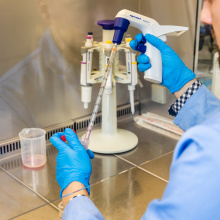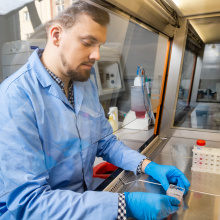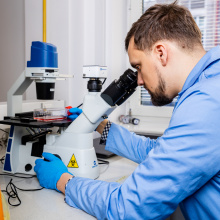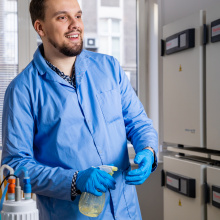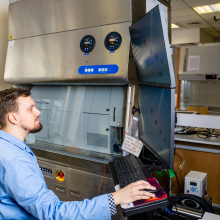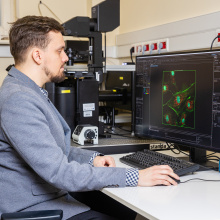Łukasz Arcimowicz is a PhD student at the International Centre for Cancer Vaccine Science, based at the University of Gdańsk. He has been scientifically involved in developing a lung cancer vaccine from the beginning. - My research focuses on interactions between the immune system and cancer. I am looking for cells that can fight the tumour and ultimately help a patient with non-small cell lung cancer to beat the disease. We invite you to read the following interview in the 'UG Young Scientists' series.
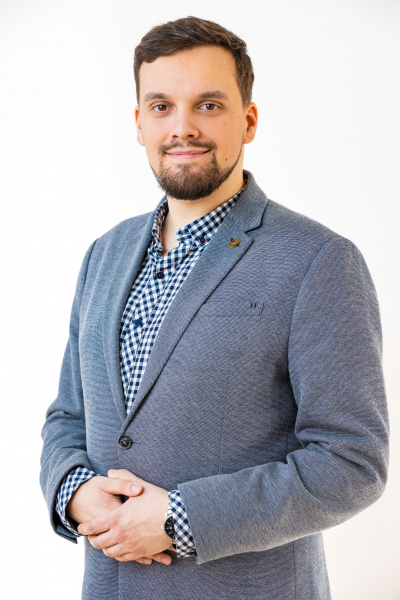
Fot. Alan Stocki/UG
Elżbieta Michalak-Witkowska: - You are very young, yet you have been involved for four years in a serious, extensive and hopeful project for oncology patients. I imagine this is quite a responsibility - do you feel it daily?
Mgr Łukasz Arcimowicz: - The project is large and very ambitious. That is why I have been involved in it from the beginning. Working at ICCVS brings me a lot of satisfaction. I look to the future with hope and, at the same time, realism, and I believe that the research undertaken within the centre's activities will, in the future, lead to the creation of a personalised anti-cancer therapeutic vaccine for patients with non-small cell lung cancer. And not only that.
- Non-small cell lung cancer is perhaps the most common human malignancy.
- Yes. Unfortunately, it is also cancer that has a very high mortality rate with current therapies such as chemotherapy, radiotherapy and surgery. It comprises around 80 per cent of all lung cancer cases and most often affects smokers (90 per cent of patients). For the most part, the disease is due precisely to having smoked for a good few years. However, there are also people among the patients who smoked cigarettes in the past and have long since given up the habit.
- What do the lungs of such an advanced smoker look like?
- During the examination, we analyse both the tumour and a 'healthy' lung fragment—a healthy lung, i.e. one unaffected by cancer. You can imagine that in a smoker, even a tumour-free lung fragment looks different from that of a non-smoker - we even notice changes with the naked eye, which are not present in a healthy body, in healthy tissue.
- What specifically do you do in the project? What do you pay the most attention to?
- I work with a large, international team led by Prof Natalia Marek-Trzonkowska, director of the ICCVS. Here we have experts and scientists from different fields, such as biotechnologists, bioinformaticians, chemists or veterinarians, with a common goal - a vaccine for cancer.
Working on clinical samples enables us to gain insight into the actual situation that occurs in patients. In our work, we, therefore, focus primarily on patient samples. This is possible thanks to the excellent cooperation with the oncologists and surgeons from the Medical University of Gdańsk, prof. Witold Rzyman, prof. Jacek Jassem and prof. Rafał Dziadziuszko, for which I am partly responsible. Often, I am the one who is in contact with them and receives the material for research from them - on the same day when the operation takes place; we get a call that the material is waiting for us. We collect it and prepare it for testing in the laboratory - that is my role.
- You are the link between the hospital and the lab, but you also look for hours a day in the lab for cells ready to fight the tumour.
- You could say that. It is a complex issue. We digest the material we receive, which means we grind it down to individual cells. This is a tremendous amount of work involving the entire team to which I belong - the Tumour Immunology team. We separate the cells isolated in this way into the immune cells in the tumour, i.e. the cells of the immune system and the tumour cells. We focus mainly on the immune cells and isolate from them the populations that can fight the tumour and the populations that, in a way, support its growth. This is because our immune system contains cells that can destroy tumours and those that counteract and are used by the tumour to defend itself.
- Is teaching the immune system to recognise and deal with cancer independently possible?
- This is what personalised immune therapies are all about: using the immune system's ability to destroy the patient's cancer cells. Under normal conditions, mutations occur in the body's cells daily, leading to cancer. Fortunately, in healthy individuals, a properly functioning immune system can eliminate such altered cells so that cancer does not develop.
Often, however, when our body comes into frequent contact with mutagenic agents, such as tobacco smoke, the frequency of mutations increases, including those that enable cancer cells to 'hide' from the immune system. Such a phenomenon is called an immune escape. This is the point at which the immune system cells are unable to respond to the presence of cancer. The tumour then changes its environment - called the tumour microenvironment, in such a way that it is even more hostile to the lymphocytes capable of fighting cancer. Instead, regulatory cells can suppress the immune response flow into the tumour. These cells are essential in our bodies because they protect us, for example, from immune responses directed against our tissues (from autoimmune diseases) or allergies. Still, they can also be used by cancer as allies.
- How do you find the immune cells capable of destroying the tumour?
- We use flow cytometry, which allows us to look at each cell individually for specific markers, such as proteins. We can then look at such a cell and see whether it is a regulatory cell that will protect the tumour or a cell that has the potential to destroy it. With one such look, we can analyse up to 16 features of a single cell.
- You have started the project's next stage- conducting the first animal studies. Can you already talk about success?
- It is still too early for that, but it should be emphasised that some of our results are very promising.
- So you notice that the tumour fragment transplanted into mice shrinks when the corresponding cells are administered?
- Let me answer more descriptively. A mouse to which we administer a tumour fragment subcutaneously is deprived of its immune system, i.e. it cannot fight the tumour itself in any way. The tumour cells can multiply freely in the body. When we give mice cells isolated, multiplied from a patient - from the same patient from whom the tumour fragment was given - we sometimes observe that the tumour shrinks. We have also observed how the tumour defends itself against the therapeutic cells. On the other hand, knowing the enemy's strategy is already the first step towards defeating it. We have further research ahead of us in this direction.
- Until?
- Until we are confident that our assumptions work and we can select the suitable cells to fight cancer effectively.
- The following stages will be trials with patients.
- Yes, but there is still some time to wait for that.
- Ultimately, a personalised vaccine will be developed. It is worth adding that it will not be a finished product but more of a therapeutic strategy.
- The term 'vaccine' is, in fact, sometimes misleading and is mainly associated with preventive vaccinations against a specific disease. In our case, a vaccine refers to a particular drug or therapeutic strategy that will be selected for a specific patient. Based on the data obtained in the studies, it will be implemented in the patient when the disease has already occurred, i.e. with a distinct immune status.
- In addition to your current project, what will you take on shortly?
- I am thinking about my project, which will be the analysis of individual lymphocytes in terms of their transcriptome, i.e. RNA sequences. That is, I will need to know what these cells are producing at any given time. This method provides a complete set of information and allows me to analyse every single cell. I received a grant for this research last year, and it will let me look even more closely at the cells of the immune system and their individual populations.
- Thank you for the interview.

